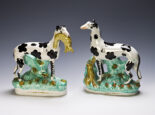Steam along the Nene
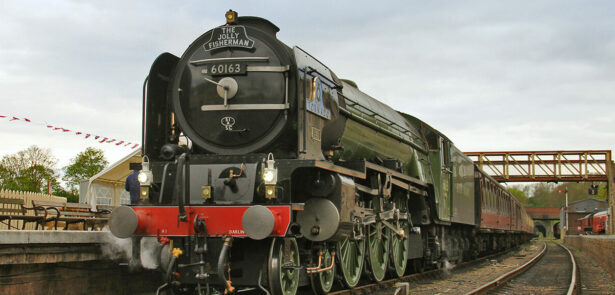
One of this region’s biggest tourist draws is the Nene Valley Railway, running from Peterborough to Wansford and Yarwell. Yet, even if you’ve never been, you’re probably already quite familiar with it. RICHARD GUNN explains why and also explores the history of the line as well as meeting some of the vital people who make it all happen.
We’ll start with a question. Can you name any major films or television shows in which Peterborough and its surrounding district have played a prominent role? Answers probably don’t flow that readily – after all, the city has yet to achieve the same celluloid glamour of London, Paris or New York – but, since 1977, getting on for 200 movies, commercials and TV episodes have been staged in a particular part of the area. There have been two Bond movies, Steven Spielberg’s Band of Brothers, Agatha Christie’s Hercule Poirot has been a regular visitor, pop groups have filmed promo videos and there have been countless major incidents on behalf of Casualty, EastEnders, Dalziel and Pasco, London’s Burning and The Bill.
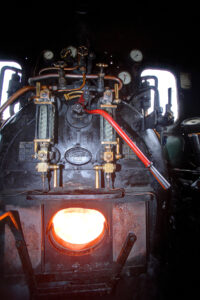 But if urban and rural Cambridgeshire in the background haven’t seemed obvious, that’s probably because, quite often, the locations have been masquerading as somewhere else in the world. Over nearly 50 years, Peterborough, Wansford and several points between the two have pretended to be Germany, France, Denmark and Russia, as well as numerous different UK localities. And the reason for this pseudonymous celebrity status is the Nene Valley Railway, the preserved line that runs from near the centre of Peterborough, out alongside the river, through Ferry Meadows Country Park and onto Wansford and Yarwell. The seven- and-a-half mile route has become one of the country’s premier historic railways since it opened in 1977.
But if urban and rural Cambridgeshire in the background haven’t seemed obvious, that’s probably because, quite often, the locations have been masquerading as somewhere else in the world. Over nearly 50 years, Peterborough, Wansford and several points between the two have pretended to be Germany, France, Denmark and Russia, as well as numerous different UK localities. And the reason for this pseudonymous celebrity status is the Nene Valley Railway, the preserved line that runs from near the centre of Peterborough, out alongside the river, through Ferry Meadows Country Park and onto Wansford and Yarwell. The seven- and-a-half mile route has become one of the country’s premier historic railways since it opened in 1977.
However, some of its appeal lies not in its Britishness, but quite the opposite. For the railway is unique in Europe; it operates rolling stock and coaches from 10 different countries, allowing it to switch identity to anywhere it – or rather, those with the cameras – want it to be. But aside from its starring roles, the railway also functions as one of Peterborough’s main tourist and family attractions, operating all year round. Since it opened as an independent heritage railway, over a million people have visited and travelled on the line. Although how many of them have actually recognised it, despite the fact they’ve probably seen it on the large or small screen many times?
The line that now forms the Nene Valley Railway was the earliest to reach Peterborough, with the first train leaving the city on June 2, 1845. The route to London was quite a tortuous one; from a station on the eastern side of the Town Bridge (one platform of which still remains, although the palatial buildings have long since gone) out to Wansford, onto Northampton and from there to Euston. Visit that London terminus now and, on one of the two Victorian lodges that stood either side of its famous (now demolished) Euston Arch, you’ll still see Peterborough inscribed as a destination on the stonework.
The London and Birmingham Railway started building its line to Peterborough in 1843. Trains were still new and radical at the time and not everybody approved of them. Some local landowners were up in arms, although it seems that God was at least on the side of the L&BR, for an important supporter was the Bishop of Peterborough. The company overcame the objections however, and the line was remarkably completed in little over a year, at a very reasonable cost of £429,409. The biggest undertaking was the 617- yard Wansford Tunnel, still a feature of the Nene Valley Railway today. The scale of the task was marked by the difference in wages; normal labourers got 12 shillings a week, those on tunnel work got an impressive 30. Thanks to the area being one of the UK’s main brick-making centres, the bricks to construct it were made from local clay rather than brought in, which undoubtedly helped keep costs down.
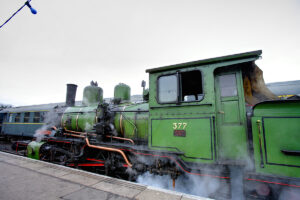 However, the large number of navvies – by the summer of 1844, there were 1000 in the area – did bring some social problems. Peterborough even had to reinforce its police force, from four men up to five! A further two officers were seconded from Manchester to help keep the peace amid the earth huts that the workers lived in around Wansford.
However, the large number of navvies – by the summer of 1844, there were 1000 in the area – did bring some social problems. Peterborough even had to reinforce its police force, from four men up to five! A further two officers were seconded from Manchester to help keep the peace amid the earth huts that the workers lived in around Wansford.
Around 8000 people turned out to greet the first train, at a time when Peterborough’s total population was only 7000. A second train, in the afternoon, brought even more people. So when the time came for the crowds to disperse – naturally with a large number deciding to go by the new-fangled railway – it turned into chaos. The return service was packed beyond capacity, so much so that fights broke out and passengers took to the carriage roofs. In a move that would give a modern Health & Safety officer apoplexy, the train left with people actually still on top of the carriages. The guard apparently stopped the service before any low bridges so he could warn those overhead to keep their heads down. It was ‘gratifying everything had passed off so pleasantly’ reported the Stamford Mercury with none of the tabloid hysteria that would no doubt surround such an incident today.
The total travelling time to London was about five hours, but this was still much faster than the capital could have been reached previously, by coach or horse. In 1846 the London and Birmingham Railway was taken over by the larger London and North Western Railway, resulting in it also gaining control of the Peterborough branch. But rival companies were already threatening the L&NWR’s dominance of the city. Other lines soon arrived, and by 1847, there was a competing way to London, courtesy of the Eastern Counties Railway’s new route via March and Ely. In 1850, the Great Northern Railway opened its direct line to London, terminating at Maiden Lane in Islington as King’s Cross Station was still two years away from completion.
While this robbed the Peterborough to Northampton railway of some of its prosperity and importance, it continued to do well. Wansford became a junction in 1867 with the opening of
a line to Stamford, and in 1879 there was a further extension offering direct access to Rugby. In fact, it allowed more than that, since the continuing spider’s web of lines allowed passengers from Peterborough to get to North Wales and, via ship, to Ireland. Finally, in 1883, a connection was added to the Great Northern Railway’s East Coast Main Line, at Fletton.
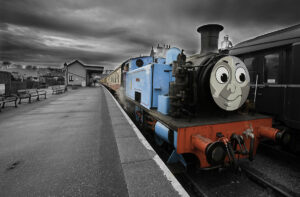 In 1923, the London, Midland and Scottish Railway took over control, although most of the rest of the network around Peterborough was operated by the rival London and North Eastern Railway. During the Second World War, Castor Station on the line was damaged by a V1 ‘Doodlebug’ flying bomb that landed nearby, launched from a Heinkel H111 bomber over Wisbech. A few years after the hostilities came to an end, the rail network was nationalised into British Railways, in 1948. But, by then, usage was declining, a trend that would only accelerate thanks to the growth of car ownership, and the route was one of many to feel the effects of this. Wansford Station closed in 1957, passenger services through to Northampton ended in 1964 and those to Rugby ceased in 1966. The line continued for freight, and there was even the occasional special for Oundle School pupils, but in 1972, British Rail closed the line completely.
In 1923, the London, Midland and Scottish Railway took over control, although most of the rest of the network around Peterborough was operated by the rival London and North Eastern Railway. During the Second World War, Castor Station on the line was damaged by a V1 ‘Doodlebug’ flying bomb that landed nearby, launched from a Heinkel H111 bomber over Wisbech. A few years after the hostilities came to an end, the rail network was nationalised into British Railways, in 1948. But, by then, usage was declining, a trend that would only accelerate thanks to the growth of car ownership, and the route was one of many to feel the effects of this. Wansford Station closed in 1957, passenger services through to Northampton ended in 1964 and those to Rugby ceased in 1966. The line continued for freight, and there was even the occasional special for Oundle School pupils, but in 1972, British Rail closed the line completely.
Preservation
By this time, the nucleus that would grow into the Nene Valley Railway had already formed. When steam was withdrawn from BR in 1968, a local clergyman, Richard Patten, purchased a Class 5 steam loco for scrap value. The intention was to have the engine, numbered 73050, on display outside Peterborough’s technical college. However, it was in such good order that it managed to travel from Manchester to Peterborough under its own power, despite a ban on steam. The trip took place, surreptitiously by night, a month after the last official steam services had operated on the UK’s network. The decision was taken to restore the loco – which was only then 14 years old – to full working order instead. In 1970, the Peterborough Locomotive Society was formed by enthusiasts to do just that.
Restoration started at Baker Perkins Ltd, before the locomotive was moved to the British Sugar Corporation’s factory, off Oundle Road, adjacent to what would become the Nene Valley Railway. This had its own internal rail system and was the home of Thomas, a small blue tank engine named by the Reverend Wilbur Awdry in 1971. The Reverend Awdry was famous for his books about a certain other blue tank engine by the name of Thomas, plus his friends of course, and the locomotive he christened remains on the NVR to this day, bringing much joy and delight to young visitors. Around this time, Peterborough’s City Council and the County Council submitted a plan to the government to site the National Railway Museum in the city. Ultimately, Peterborough lost out to York, but the side- proposal of turning the line along the River Nene into a heritage route persisted. Following a positive public meeting in 1972, the PLS became the Peterborough Railway Society and pressed on with this scheme, supported by Peterborough Development Corporation and the relevant councils. Two years after that British Rail shut the line, the Development Corporation bought the section between Longueville and Yarwell to lease to the PRS.
 For the volunteers of the PRS, the task ahead was enormous. Many of the stations had been knocked down and maintenance neglected for years. There was no connection to the mainline network or even to the British Sugar Factory’s site where the society stored its stock, including 73050. Wansford station and its adjacent yard were now in private hands. Getting any sort of train service going again was going to be extremely tough.
For the volunteers of the PRS, the task ahead was enormous. Many of the stations had been knocked down and maintenance neglected for years. There was no connection to the mainline network or even to the British Sugar Factory’s site where the society stored its stock, including 73050. Wansford station and its adjacent yard were now in private hands. Getting any sort of train service going again was going to be extremely tough.
One member of the PRS offered the use of his ex-Swedish Railways steam locomotive. Foreign stock however is built to a larger size (loading gauge) than its British equivalent. That meant the engine couldn’t be used on the line as it was. However, a survey of the route revealed that, with some platform alterations and the demolition of a bridge, the Nene Valley line could accommodate continental trains as well as traditional British fare.
Wansford was chosen as the main base of operations, with a shuttle service through Wansford Tunnel – the longest on a UK preserved line – beginning in 1975. The upgrading of the rest of the line for passenger traffic, as far as Orton Mere Station, took until May 1977. Locomotives from Britain, Denmark and France arrived, along with enough carriages to mean that, on June 4, 1977, the Nene Valley Railway was able to start operating its own public services.
There were still lots of obstacles to overcome, such as the lack of facilities – for visitors and staff alike – at Wansford and the fact that the eastern Orton Mere terminus was far from satisfactory. Many visitors unfamiliar to Peterborough couldn’t even find it! Improvements were gradual, as and when finances allowed. A locomotive turntable was installed at Wansford in 1978, and in 1980, a weekend British Rail shuttle service started operating between Peterborough’s mainline station and Orton Mere. An extension to Yarwell opened in 1983, as did an additional shed at Wansford, in addition to the locomotive accommodation constructed in 1980.
 For 1984, an appeal was launched to expand the line properly into Peterborough. This was achieved in 1986 when the first passenger train ran to Peterborough Nene Valley Station, on the south side of the river and within easy walking distance of the centre. At last, it gave the Nene Valley Railway a proper eastern terminus, plus a total round trip length of 15 miles. The new stretch was opened by Prince Edward who, the summer before, had been tied to the track in front of a locomotive. It’s perhaps not often such an encounter would encourage
For 1984, an appeal was launched to expand the line properly into Peterborough. This was achieved in 1986 when the first passenger train ran to Peterborough Nene Valley Station, on the south side of the river and within easy walking distance of the centre. At last, it gave the Nene Valley Railway a proper eastern terminus, plus a total round trip length of 15 miles. The new stretch was opened by Prince Edward who, the summer before, had been tied to the track in front of a locomotive. It’s perhaps not often such an encounter would encourage
a member of the Royal Family to return, but Edward was a Cambridge University student at the time and the whole thing was a Rag Week stunt. The improvements continued into the next decade. In 1995, the impressive Wansford Station building was opened at a cost of £250,000. It was brand new yet designed to blend in with the existing, much older structures on the site. Three years later, Ferry Meadows got a new station as well. Well, sort of. This one was a genuine original railway structure, albeit actually the 1900 Great Northern Railway goods office from Fletton High Street in Peterborough!
One of the most significant projects of the 21st century, so far at least, has been the construction of a new station at Yarwell, but there are even grander schemes ahead – and if there’s one thing the NVR has proved over the years, it’s that, when it comes to challenges, the railway is more than up to the task of overcoming them.
Easter at Nene Valley Railway
LNER A1 Tornado
The big news for railway enthusiasts this spring is that the Nene Valley will play host to the Peppercorn A1 steam locomotive Tornado – a magnificent engine liveried in green and red, straight out of the classic era of steam travel. What’s even more remarkable about this particular vehicle is that it’s actually a part-for-part replica built by a team of dedicated and determined volunteers – work began all the way back in 1990, with completion in 2008.
There will be several opportunities to ride behind the Tornado between 30 March and 1 April, with full details on how to book on the NVR website.
Thomas
A school holiday wouldn’t be complete without a trip out to see NVR’s very own little engine that could – Thomas is an 06-O-T 1800 steam engine that originally worked at the sugar factory in Peterborough during the 1940s and 1950s, and spends retirement in comfort chugging away along the heritage line, delighting fans old and new.
Thomas will be heading out with his cool big brother, the Tornado, during the weekend of 30 March-2 April, and will also be available for rides during February half-term (17th 18th 24th and 25th) and the last weekend of every month until the end of October.
Eat, drink and be… murdered?
NVR’s successful themed journeys continue, with the opportunities for delicious fish and chip suppers, afternoon tea – and even a murder mystery evening this spring. Climb on board the Flying Codman and the Jolly Fisherman for a quintessential British experience of fish, chips and a steam-powered train ride, or a genteel afternoon tea straight out of the 1950s aboard authentic British Standard MK1 carriages from that era. If it’s the full Agatha Christie vibe you’re after, look no further than RAW Theatre’s immersive murder mystery evenings – where you are the detective.
THE NENE VALLEY RAILWAY
Wansford Station, Stibbington, Peterborough, Cambridgeshire, PE8 6LR
Telephone: 01780 784444 Website: www.nvr.org.uk












